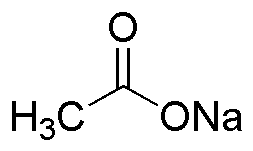Sodium acetate, anhydrous is widely utilized in research focused on:
- Food Preservation: It acts as a food additive, helping to regulate acidity and enhance flavor in processed foods, ensuring longer shelf life.
- Buffer Solutions: Commonly used in laboratories, it helps maintain pH levels in biochemical experiments, providing stability for various reactions.
- Textile Industry: Employed in dyeing processes, it improves the fixation of dyes on fabrics, resulting in vibrant colors and better wash fastness.
- Pharmaceuticals: Utilized in the formulation of certain medications, it aids in drug delivery systems, enhancing the solubility of active ingredients.
- Heating Pads: Its ability to release heat upon crystallization makes it ideal for reusable heating pads, providing a convenient solution for pain relief.
General Information
Properties
Safety and Regulations
Applications
Sodium acetate, anhydrous is widely utilized in research focused on:
- Food Preservation: It acts as a food additive, helping to regulate acidity and enhance flavor in processed foods, ensuring longer shelf life.
- Buffer Solutions: Commonly used in laboratories, it helps maintain pH levels in biochemical experiments, providing stability for various reactions.
- Textile Industry: Employed in dyeing processes, it improves the fixation of dyes on fabrics, resulting in vibrant colors and better wash fastness.
- Pharmaceuticals: Utilized in the formulation of certain medications, it aids in drug delivery systems, enhancing the solubility of active ingredients.
- Heating Pads: Its ability to release heat upon crystallization makes it ideal for reusable heating pads, providing a convenient solution for pain relief.
Documents
Safety Data Sheets (SDS)
The SDS provides comprehensive safety information on handling, storage, and disposal of the product.
Product Specification (PS)
The PS provides a comprehensive breakdown of the product’s properties, including chemical composition, physical state, purity, and storage requirements. It also details acceptable quality ranges and the product's intended applications.
Certificates of Analysis (COA)
Search for Certificates of Analysis (COA) by entering the products Lot Number. Lot and Batch Numbers can be found on a product’s label following the words ‘Lot’ or ‘Batch’.
*Catalog Number
*Lot Number
Certificates Of Origin (COO)
This COO confirms the country where the product was manufactured, and also details the materials and components used in it and whether it is derived from natural, synthetic, or other specific sources. This certificate may be required for customs, trade, and regulatory compliance.
*Catalog Number
*Lot Number
Safety Data Sheets (SDS)
The SDS provides comprehensive safety information on handling, storage, and disposal of the product.
DownloadProduct Specification (PS)
The PS provides a comprehensive breakdown of the product’s properties, including chemical composition, physical state, purity, and storage requirements. It also details acceptable quality ranges and the product's intended applications.
DownloadCertificates of Analysis (COA)
Search for Certificates of Analysis (COA) by entering the products Lot Number. Lot and Batch Numbers can be found on a product’s label following the words ‘Lot’ or ‘Batch’.
*Catalog Number
*Lot Number
Certificates Of Origin (COO)
This COO confirms the country where the product was manufactured, and also details the materials and components used in it and whether it is derived from natural, synthetic, or other specific sources. This certificate may be required for customs, trade, and regulatory compliance.


